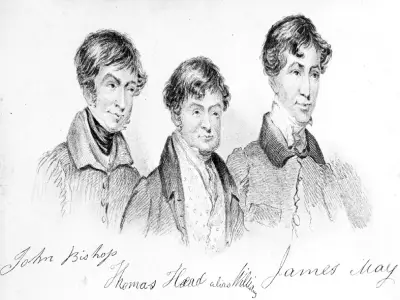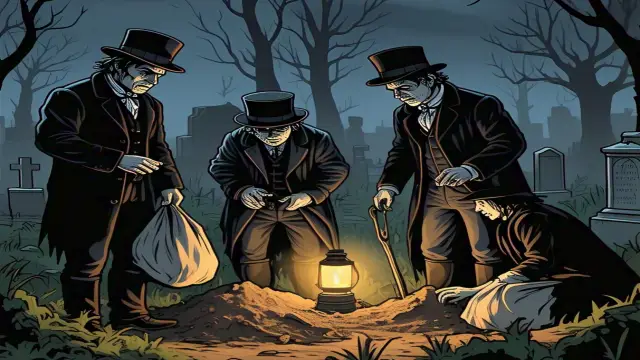Bishop, Williams, May, 19th-century murder trial
The trial of John Bishop, Thomas Williams, and James May is one of the most infamous cases in 19th-century British legal history. Accused of murder and grave robbing, their trial captivated the public and exposed the dark underworld of body snatching. This is the story of their trial, the evidence presented, and the dramatic verdict that shocked the nation.
The Accused and Their Statements
The trial began with written statements from the three prisoners, each attempting to defend themselves against the charges.
John Bishop’s Statement:
Bishop claimed he was a “carrier” who supplied bodies to teaching hospitals. He insisted he only dealt with bodies that had died naturally. He admitted to buying a cap from Mrs. Dodswell but denied any knowledge of the clothing found in his garden.
Thomas Williams’s Statement:
Williams’s statement was evasive. He portrayed himself as an innocent bricklayer and glassblower who was merely helping Bishop. He ended with a plea to the jury’s “intelligence and discrimination,” likely added by his lawyer.
James May’s Statement:
May described himself as a happily married family man and a butcher by trade. He admitted to procuring anatomical specimens for medical institutions but denied any involvement in murder. Like Williams, he concluded with a plea to the jury’s “intelligence and discernment.”

Character Witnesses and Testimonies
The defense called several character witnesses, but their testimonies were unconvincing and often contradictory.
Rosina Carpenter:
A single woman who claimed May was with her on the night of November 4th. She insisted he had no human teeth in his pocket.
Mary Ann Horne:
Another single woman who testified that May was with her until the morning of November 5th. She described him as a “fine, dependable fellow.”
Charlotte Berry:
A neighbor of Horne who tried to explain bloodstains on May’s trousers by blaming a jackdaw’s injury. Her testimony was met with skepticism.
Dr. Edward William Tuson:
A surgeon subpoenaed by the defense, Dr. Tuson admitted he had no idea what he was supposed to prove. His testimony was brief and unhelpful.
The Jury’s Deliberation and Verdict
After hearing the evidence, the jury retired to deliberate. Just thirty minutes later, they returned with their verdict.
The Verdict:
All three men—Bishop, Williams, and May—were found guilty of murder. The courtroom erupted in cheers and applause, forcing the windows to be closed to restore order.
The Sentence:
The judge sentenced the men to death by hanging. Their bodies were to be handed over to anatomists for public dissection, a fate meant to serve as a grim warning to others.
The Aftermath
The trial of Bishop, Williams, and May exposed the dark trade of body snatching and the lengths to which individuals would go for profit. Their execution and dissection marked a turning point in public awareness of the need for legal reforms in anatomical research.
Conclusion
The trial of Bishop, Williams, and May remains a chilling reminder of a darker time in history. It highlights the importance of justice, the dangers of greed, and the need for ethical practices in science and medicine.
As we reflect on this case, we are reminded of the progress made in legal and medical ethics—and the lessons we must continue to learn from history.
Visit the Old Bailey or explore historical archives to learn more about this fascinating case. Share this story to keep the lessons of the past alive for future generations.

